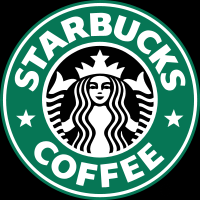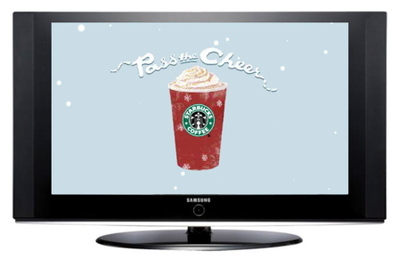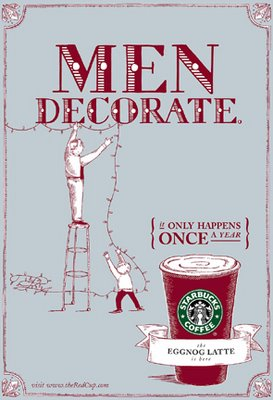Among business practices, advertising is unique for the amount and variety of attention it receives. There is increasing interest nowadays not only in the number of advertising messages produced but also in the qualitative differences between advertising messages. The lack of market information and of competition that would prevail in the absence of advertising would be costly to consumers: as some sellers offering bargains failed to attract buyers, others would find it possible to exploit a degree of monopoly power. Hence, the choice again is not whether advertising is perfect but whether the benefits of advertising outweigh the costs so that the social welfare is greater (Schultz and Kitchen 101).
Starbucks is one of the leading coffee retailers which spends millions of dollars on advertising and promotion. Its advertising campaigns are marked by uniqueness and emotional appeal, vivid and bright images and persuasive messages. Similar to other companies, Starbucks passes information to markets through promotion and receive information from them through feedback. Through promotion, Starbucks unleashes stimuli and supplies the marketplace or components of the marketing network with informative and persuasive messages in order to stimulate, reinforce, or modify behaviour.
For Starbucks, marketing communications serve four basic management purposes. First, the bridge information gaps existing among manufacturers, middlemen, and customers. Second, they help coordinate the promotional activities of the total marketing system to achieve a coordinated thrust. Third, they help adjust the system to the customer and consumer requirements. Fourth, they adjust and help in adjusting the product to customer needs (Schultz and Kitchen 105).
The impact of a message on consumer behaviour, which is governed by intervening variables, determines its marketing effectiveness. Since Starbucks cannot control the personality of recipients, the environment in which messages are relayed, the environments surrounding responses, the group norms, and the relationships of individuals to groups, they have difficulty in assuring effective communications. In Starbuck’s advertising campaign, a common ad strategy is, to begin with, a problem description, which often activates unpleasant feelings in viewers (Brassington and Pettitt 34).
The product is then presented as a solution to the problem, and an emotionally satisfying resolution is portrayed. In such an ad, achieving positive attitudes may depend on the complete sequence of emotional responses. In sum, because they are directly tied to the responses intended by the advertiser, ad-specific feelings may offer a useful view of the advertising influence process. This includes both how it works and when it fails. This advantage may be enhanced in conjunction with other data like a prompted retrospective protocol that reveals cognitive responses (Brassington and Pettitt 36; Starbucks Television Advertising 2007).
One of the most unique and impressive advertising campaigns took place in 2007 when the company decided to use a TV medium for promotion and advertising. The aim of the campaign was to promote the brand image and create a core of loyal supports. This advertising campaign focuses on how consumers process the brand information conveyed in an advertisement (Schultz and Kitchen 108; Starbucks Television Advertising 2007).
The consumer has been seen as an active information seeker who views advertising to learn all that can be learned about the brand in order to make the optimal choice. Starbucks has long sensed that the way in which the message is conveyed is at least as important as what the message says. But it has been only in the last few years that Starbucks has begun to conceptualize and to attempt to capture emotional reactions to ads (Schultz and Kitchen 109).
The uniqueness of Starbucks’ approach to advertising is that the company uses its authentic logo “twin-tailed siren” or “Siren’s Eye” (Appendix, Advertising 1). The communications process is concerned with the dissemination of stimuli and their perception, impact, use, and effectiveness. Also, it appeals to the mind of consumers using the following messages: “Let’s meet at Starbucks” and “Only Happens Once a Year” (Starbuck is New to Advertising 2007; Appendix, Advertisement 3). Marketing communications have meaning to the extent that an individual’s predisposition or experience permits him to see, hear, or read them (Schultz and Kitchen 103).
Two factors govern the relationship between a message and its recipient. These are the sender set and the customer set. The former includes media, appeal, advertiser, copy, theme, and layout. The latter, containing the individual differences of people and their psychological, social, and economic situations, intervenes between the sender and the receiver of marketing information (Brassington and Pettitt 40).
The message of Starbucks is best on its brand image and high-quality coffee beans used in its products. It is not only the message but also the way in which it is presented that results in communications. The visual messages are informative and persuasive. For instance, the actual physical shape of a product, its colour, or the choice of words in the promotion condition the effectiveness of the communications (Appendix, Advertisement 2)
The absence of slogan and textual representation limits its emotional impact and appeal. Thus, this technique allows Starbucks to concentrate consumers’ attention on the visual image and taste of a product. The dominance of learning-based advertising response has shifted to a more balanced approach which includes the evaluation of the ad itself, as well as the emotional reactions to the ad (Starbucks Television Advertising 2007).
The emotional reactions one has in response to an ad may influence what gets activated from memory, increasing the likelihood that valence-congruent thoughts are activated. If the emotional reaction is positive, more positive thoughts may be generated in response to the message of the ad. As a result of this process, more positive beliefs will be formed about the brand’s attributes, and the evaluation of the ad itself will be enhanced.
Following Schultz and Kitchen (101), emotions influence decisions in various ways. Emotion may define the objective of the decision-maker. Emotional intensity used by Starbucks causes the range of alternatives that would be considered to be narrowed, and emotional factors often intrude upon the decision-making process by curtailing the amount of consideration given to logical factors. Because intended feelings capture a major component of the responses intended by the creator of the ad, their intensity should reveal details of the process of influence (Schultz and Kitchen 143).
This may be especially important for intended sequences of feelings. While the preceding figures may readily be categorized as symbolic portrayals of emotion, the occurrence of such symbols in social interaction is less apparent. However, one could argue that such basic expressions as smiling and frowning appear in so many contexts and so often that they have become symbols of emotion (Brassington and Pettitt 41).
The min idea of promotion and persuasion techniques is that the advertisement itself links the brand with the capacity to provide the consumer with an experience that is different from the consumption experience that would normally be expected to occur without exposure to the advertisement. A critical aspect of this approach is that transformation is a characteristic of an advertisement such as emotion, information, image, or humour (Starbucks Television Advertising 2007).
Rather, it is the process through which advertisements affect consumption behaviour. Thus, one does not set out to construct a transformational advertisement since, according to this proposal, ads work by transforming the consumption experience. Hence, one uses knowledge of the transformation process to develop measures of the effectiveness of an advertisement and to diagnose which aspects of the transformation process are functioning in that ad (Schultz and Kitchen 191).
This proposition states that “thinking” ads can produce a rapid transformation effect while “feeling” ads usually will require multiple exposures overtime before producing a transformation effect. This differential effect is attributable to the interaction of the advertisements and the environment in which they are processed (Kitchen 32). Specifically, the environment contains many different stimuli, all of which compete for the consumer’s limited attention capacity.
Thus, well-executed thinking ads, which are often more direct and easier to process, will produce a more immediate effect than feeling ads, which often involve a higher level of abstraction (Waldman and Jensen 91). The consumer is capable of expressing cognitions relative to the consumption experience; he or she just may not be capable of reliably tracking the source of those cognitions to the advertisement (Schultz and Kitchen 182; Starbucks Home Page 2008).
Following Schultz and Kitchen (141), emotion attribution theory postulates that arousal resulting from ads is generic or nonspecific, and the attributions the consumer has about the arousal determine the quality and quantity of the resulting emotions. In this model, the threatening ad message induces varying levels of arousal in the ad recipient, depending on the perceived level of fear in the ad. Arousal triggers the attribution process, which influences emotional responses to the ad.
The higher the level of arousal, the stronger the need for attribution and the more (or less) intense the emotional response. The underlying principle of the proposed model is that the effectiveness of the ad depends on whether the receiver attributes the resulting arousal to the message (Brassington and Pettitt 44; Starbucks is New to Advertising 2007). Advertising, as a form of persuasive communication, relies on the portrayal and arousal of emotion.
However, whereas television commercials utilize both visual and auditory messages over a period of time, magazine advertisements are limited to images and words on a printed page and to a static rather than dynamic portrayal. In some instances, the facial expression is the primary way through which emotion and feelings are communicated (Chitty et al. 41). “Starbucks has convinced the whole world, including the ad world, that they have become so successful just by the great taste of their coffee alone” (Starbucks is New to Advertising 2007).
The rationale for a tailored set of emotional responses or feelings is straightforward. Starbucks advertisements produce a positive attitude toward the brand by evoking an intended sequence of emotional (and cognitive) responses in viewers. Ad-specific feelings are designed to measure the particular emotional responses intended by the advertiser (Pickton and Broderick 33). As such, these responses should be good predictors of the resulting overall attitudes.
Most people are willing to accept the proposition that advertising contains information about qualities, such as price or the way a dress looks, that a consumer can determine before his purchase of a brand-in my terminology, search qualities. There is no similar agreement about advertising’s information role for qualities, such as the taste of a brand of tuna fish, that a consumer discovers only by actually purchasing and trying out a brand–experience qualities (Pickton and Broderick 31).
A consumer cannot investigate all of the alternative qualities of the goods in the market. In order to make decisions about his sample size, the consumer must make a utility assessment of these qualities. Suppose, then, that the consumer converts these qualities to some utility measure (the particular measure does not matter as long as he uses the same measure throughout). The utilities of all of the alternatives he faces for a particularly good form a probability distribution. Having chosen whether he will search for or experience a given quality, the consumer is confronted with a probability distribution of the utilities of search qualities and with a probability distribution of the utility of experience qualities (Chitty et al. 48; Starbucks is New to Advertising 2007).
The task of Starbucks advertising is to get people or markets to progress from a state of unawareness, or even negative reaction, to one of positive action. The stages in this progression are unawareness, awareness, comprehension, conviction, and action (Griffin and Mcarthur 19).
Opposing the marketing communications in this endeavour are such countervailing forces as competitors’ communications, predispositions, noise, brand loyalty, and habit. Advertising affects both costs and revenues; used effectively, it can increase sales and profits. It supplements and improves the effectiveness of other elements of the marketing mix, alters the predisposition of potential purchasers, provides information, and gains brand loyalty, attracting customers and stimulating consumer desire and action (Chitty et al. 49).
For Starbucks, this advertising campaign also helps create and maintain marketing systems. It can foster coordination and linkages of manufacturers, wholesalers, and retailers. For the marketing task is not complete with the sale of the product, satisfied customers must be retained. Continued advertising after purchase gives the customer public acknowledgement of his wise choice and tends to eliminate or reduce cognitive dissonance (Pickton and Broderick 82).
The customer is reassured and resold. Repeat business is the avenue to continued success, and post-sale advertising often the course to repeat business. Advertising is a concomitant of modern society. It is an essential ingredient of an abundant economy regardless of the dominant form of political or economic organization. Management’s challenge is how to use advertising effectively, not only to promote corporate goals but also to meet the broader aims of society (Clow and Baack 92).
The advertising campaign has a certain impact on the market structure and target audiences. Current advertising aimed to attract middle and low-class consumers, blue-collar workers and middle managers. Advertising fosters the sharing of markets and stabilizes market structures without the development of cartels. The uncertainty, risk, and randomness of consumer choice that are assumed in pure and perfect competition would not permit business to exist.
Some form of market sharing or stabilization of markets is needed. Moreover, if advertising costs were eliminated, other marketing costs would have to be incurred, and in many instances, the selling job would be done less efficiently. Higher marketing costs would result (Clow and Baack 91). What of the charge that advertising maintains high monopoly prices? Empirical evidence seems to refute this contention. The past two decades have seen general price inflation. In comparing price trends among heavily advertised products with those that were not heavily advertised (Griffin and Mcarthur 19). Companies must operate in competitive environments.
They cannot merely advertise as they wish, assume that they exist in a vacuum, and establish prices as high as they would like. Following this approach, Starbucks sells on the basis of competitive market prices. “This dramatic change in marketing strategy goes to show us how seriously the company is taking the soft comp sales and declining transaction comps. Starbucks is willing to risk its go-to-market strategy by spending significant monies on television ads to lure customers during the Holiday season” (Starbucks Television Advertising 2007). Certainly, costs are factors in establishing prices, and advertising is one of these costs.
However, advertising is usually a small part of the total cost, and its influence on the price, in general, may be negligible. In fact, at times, advertising may result in savings to the consumer that are greater than the total amount spent on advertising (Clow and Baack 65; Pickton and Broderick 33).
Discussion of advertising’s roles–as an informer, persuader, facilitator of competition, a deterrent to competition, villain or saviour to the media-and influence on social values has filled many volumes. The buyer demands messages from various sources; the seller controls some of these messages directly (advertising), others indirectly, and others not at all (Kitchen 32). The cost of supplying or influencing messages to buyers varies by the information source. Unit prices for transmitting a message vary among information sources, as do the sources’ efficiencies in placing their messages before potential buyers of the particular product (Pickton and Broderick 30).
For example, the cost per message of a salesperson’s presentation may be higher than the cost per reader of a magazine advertisement. In Starbucks, the salesperson only makes this presentation to carefully selected (or self-selected) potential buyers, while the magazine advertisement is placed before many persons not interested in the product at the time. Thus the number of messages placed before potential buyers per dollar of outlay on sales promotion varies among the media (Clow and Baack 49; Starbucks Home Page 2008).
Since the density of potential buyers, the frequency of their appearance in the market, and the ease with which they can be identified all vary among products, this efficiency ratio also varies among products for a given medium (Kitchen 39). Although the characteristics of the product and its buyers strongly influence the optimal mix of media, when Starbucks controls for these by looking within an industry, firms’ media choices should be strongly affected by their sales volume and by the geographic market they serve (Pickton and Broderick 39; Starbucks Home Page 2008). The more regional or local the market served, the more likely is the firm like Starbucks to use media with lower effective geographic thresholds, such as local newspapers and spot television, in order to minimize leakages (Clow and Baack 61; Kitchen 31).
In sum, Starbucks creates unique and authentic advertising campaigns aimed to persuade consumers to try and buy its products. In view of the limited degrees of freedom and the confinement of attention to a single industry, my results can be taken only as exploratory. This variation seems to be consistent with the hypothesis that the firm’s marketing strategy variables, of which advertising is one, are simultaneously determined.
Appendix



Works Cited
- Brassington, F. and Pettitt, S. Principles of Marketing, Financial Times Management, 2003.
- Chitty, B., Barrker, N., & Shimp, T. Integrated Marketing Communication – First Pacific Rim Edition. South Melbourne: Thomson Learning, 2005.
- Clow, K.E. and Baack, D. Integrated Advertising, Promotion and Marketing Communications, Prentice Hall/Pearson Education: Upper Saddle River, NJ, 2002.
- Griffin, T., Mcarthur, D.N. A Marketing Management View of Integrated Marketing Communications. Journal of Advertising Research, 1997 (5): 19.
- Kitchen, P.J. Marketing Communications: Principles And Practice, International Thomson Business Press: London, 1999.
- Pickton, D. and Broderick, A. Integrated Marketing Communications, Pearson Education Limited: Essex, 2000.
- Schultz, D.E. and Kitchen, P.J. Communicating Globally: an Integrated Marketing Approach, Palgrave-Macmillan: London, 2001.
- Starbucks is New to Advertising. 2007. Web.
- Starbucks Television Advertising. 2007. Web.
- Starbucks Home Page. 2007. Web.
- Waldman, D. E., Jensen, E. J. Industrial Organization Theory and Practice. Addison Wesley; 3 edition.